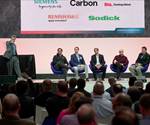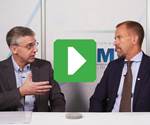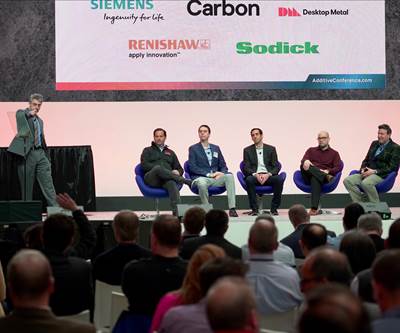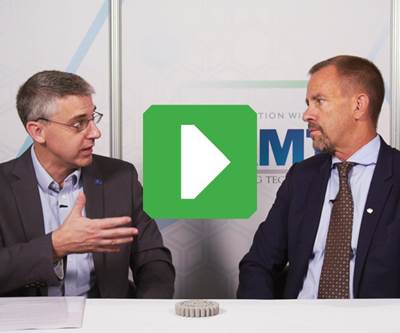Video: Additive Manufacturing Expands Design Possibilities for Automotive Lighting
Automotive lighting maker Varroc Lighting Systems describes the impact 3D printing instead of injection molding will have on car features such as headlights.
Additive manufacturing (AM) will change the face of your car — literally. Headlights appear as the “eyes” of your car, and additive will bring new possibilities for design variation here. In this video, I talk with with Dylan Schickel, innovation leader with automotive lighting system maker, Varroc Lighting Systems.
Transcript
Dylan Schickel, Varroc Lighting Systems
So, Varroc, we’re a global automotive exterior lighting supplier. We’ve got about 8,000 employees in 17 countries. Our products are on hundreds of vehicle models worldwide. In the U.S., customers see our products on a daily basis and they probably never know it.
I think additive is really interesting because additive manufacturing enables us to make useful end-use products but without the cost of conventional tooling. When we when we look at the car, the lights of the car are the eyes of the car. Much like the eyes of the person, the eyes need to convey the character and the beauty and the automotive designers use the lights as a canvas upon which to just sculpt and to put in the theme that they want in the vehicle. The auto designers would like to be able to show variance in the products. The challenge is it costs millions of dollars to build the injection molds to put a unique set of lights on the car. Additive manufacturing and other digital technologies can enable us to reduce that footprint of tooling to bring those variants to market faster and easier.
Peter Zelinski, Additive Manufacturing
So, variety in lighting is helpful, but you’re inhibited against variety right now because too many variations would be too many injection molds.
Dylan Schickel
Exactly right. The big benefit for us is going to come with the ability to produce serial production parts with additive manufacturing and put those into our lights and avoid making an injection mold for a low-volume variant or for a unique trim level or even for a unique customer.
Peter Zelinski
You expressed it in kind of a memorable way. You said the lights are the bling of the car.
Dylan Schickel
Yeah. That’s actually really true today: The cars don’t have chrome; they’re not like the cars of the 50s and 60s where the chrome trim is really there. The lights are the bling. You watch any auto commercial and you’re going to see the lights. They’re going to zoom in on the headlights, on the taillights, and the ability to bring that unique style, that unique possibility, to different variants on the same car model but without increasing the burden of the cost of the injection mold. This is the real promise for additive in our industry.
Peter Zelinski
You brought a taillight with you. Let’s open it up.
Dylan Schickel
We have a circuit board and that circuit board’s held in place by a bracket and this is kind of the unseen, the non-glorious part of things, but it’s pretty interesting. This is the kind of part that we could initially target to do in additive manufacturing.
Peter Zelinski
How does a 3D printed bracket get you to the greater range of variety?
Dylan Schickel
The different lighting scheme might require different circuit boards. If I wanted, say, five different types of circuit boards for five different types of lighting, for a conventional process I’d need five injection molds. With an AM process, I can make five at once. I can make all five of them in one print or at whatever ratio I wanted to build. I could build them just-in-time. If this week I am building variant A and next week I’m building variant C, I just print the ones that I need right when I need them. I don’t have to have those molds, set the molds up, run the inventory, store the parts, store them in the warehouse, bring them to the assembly line. I can literally print them practically just-in-time for the assembly process based on the variant that we need that particular day.
Peter Zelinski
These outer components of the assembly, the housing: These would be injection molded, but there’s room for changing the way the light operates and delivers its effect and things like a different circuit board will give you that.
Dylan Schickel
We could even move into our optical parts. The nice thing about the AM process is that it accepts the complexity well. I could add a lot of different attachments that could add a lot of different geometries that wouldn’t ordinarily be possible due to restrictions of die-drawn injection molding parts. I can make undercut features. I can make features with no draft or negative draft that wouldn’t be possible at all that can allow us to use other functional materials for some of these functions and then allow us to potentially reconfigure the whole way the lamp is put together in a quick way.
Peter Zelinski
Is there a way that ultimately 3D printing might affect the visual experience of the light? How I see the light outside the car behaving?
Dylan Schickel
We see the possibility, not now, not today, but within a couple of years to even take those optical components and make them with additive manufacturing. We’ll start with reflective parts. And then in other cases we have metalized parts that serve as a reflective surface. Those parts are very much in sight of additive manufacturing. The next level is the translucent and transparent optical parts, and this is a real challenge on the materials end of the equation. To date, none of the materials that are translucent and transparent in the AM space are really suited for optical properties. But the good news we see is in this space we have the global chemical companies entering. We have companies like BASF, companies like DSM that have been around for a long time are redoubling their efforts. I see a future where not long away we could print these transparent and translucent parts as well.
Related Content
Aluminum Gets Its Own Additive Manufacturing Process
Alloy Enterprises’ selective diffusion bonding process is specifically designed for high throughput production of aluminum parts, enabling additive manufacturing to compete with casting.
Read More3D Printing with Plastic Pellets – What You Need to Know
A few 3D printers today are capable of working directly with resin pellets for feedstock. That brings extreme flexibility in material options, but also requires greater knowledge of how to best process any given resin. Here’s how FGF machine maker JuggerBot 3D addresses both the printing technology and the process know-how.
Read MoreDMG MORI: Build Plate “Pucks” Cut Postprocessing Time by 80%
For spinal implants and other small 3D printed parts made through laser powder bed fusion, separate clampable units resting within the build plate provide for easy transfer to a CNC lathe.
Read MoreHow to Build 10,000+ Shot Molds in Hours
Rapid tooling isn’t so rapid when it takes days to 3D print a metal mold, and then you still must machine it to reach the necessary tolerances. With Nexa3D’s polymer process you can print a mold in hours that is prototype or production ready and can last for more than 10,000 shots.
Read MoreRead Next
Video: Can 3D Printed Parts Hold Self-Tapping Screws?
Automotive light maker Varroc Lighting Systems will soon begin using additive manufacturing for plastic production parts fastened into assemblies. Here are the results of its tests with self-tapping screws.
Read MoreVideo Collection: Additive Manufacturing Workshop for Automotive
If you missed the debut of the Additive Manufacturing Workshop at the North American International Auto Show, you can now watch video of all the presentations, including the Q&A session taking live questions from the audience.
Read MoreVideo: HP on Additive Manufacturing for Production
HP’s Timothy Weber discusses VW’s plans for making metal parts via AM and the way forward to implementing additive as a production process.
Read More





















